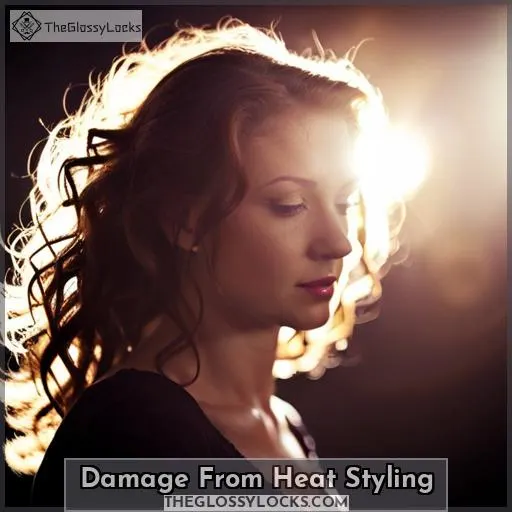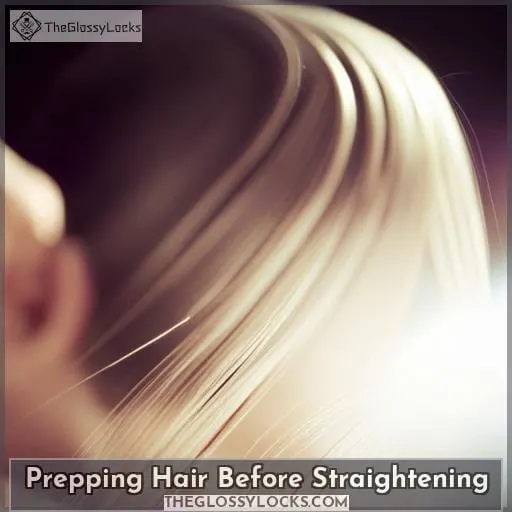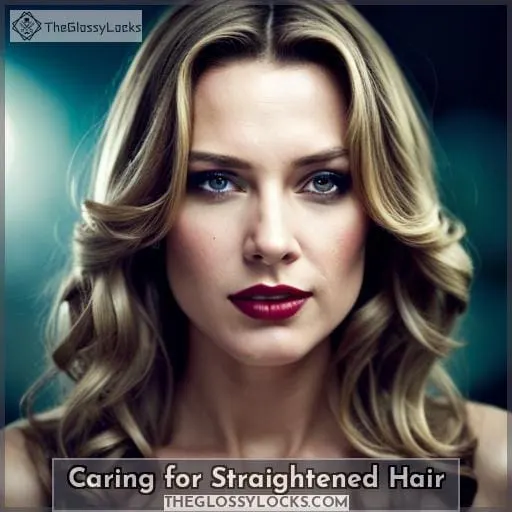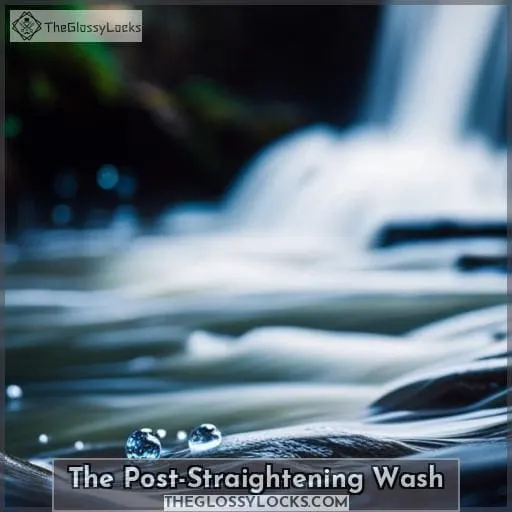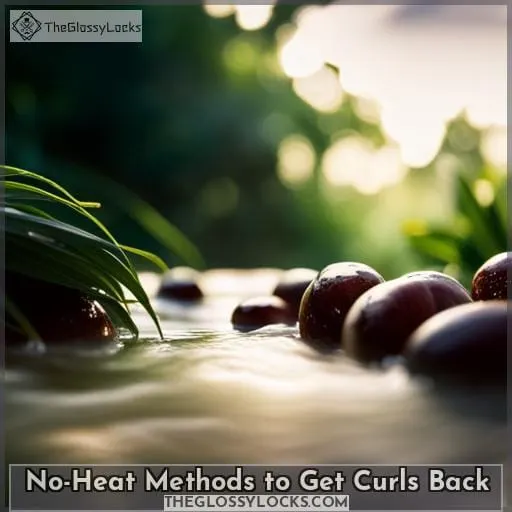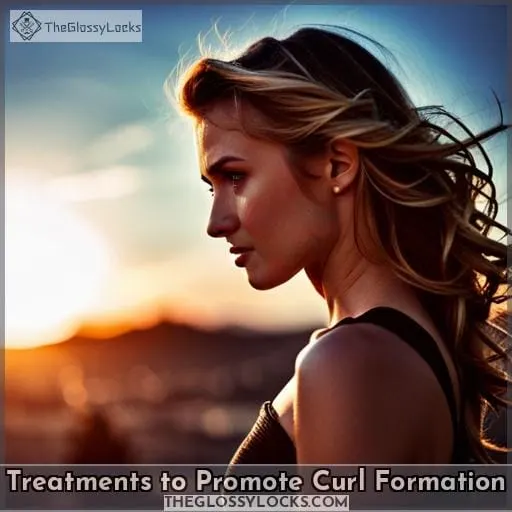This site is supported by our readers. We may earn a commission, at no cost to you, if you purchase through links.
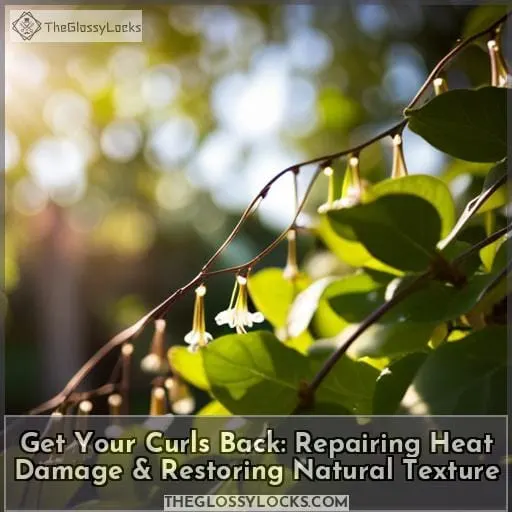 Like a phoenix rising from the ashes, your curls can be revived after heat damage. With some TLC, those limp strands can transform back into bountiful, bouncy ringlets.
Like a phoenix rising from the ashes, your curls can be revived after heat damage. With some TLC, those limp strands can transform back into bountiful, bouncy ringlets.
Strategically incorporate protein treatments, conditioning masks, and curl-enhancing products to breathe new life into overprocessed locks.
Bid farewell to frizz and split ends through gentle, curl-friendly styling techniques.
With persistence and care, your inner goddess’s flowing mane will rise again.
Table Of Contents
- Key Takeaways
- Damage From Heat Styling
- Prepping Hair Before Straightening
- Caring for Straightened Hair
- The Post-Straightening Wash
- No-Heat Methods to Get Curls Back
- Treatments to Promote Curl Formation
- Creating a Curl-Friendly Routine
- Frequently Asked Questions (FAQs)
- Can I use heat styling tools to curl my hair after straightening it?
- How long does it typically take for curls to come back after chemical straightening?
- Are there any specific hairstyles I should avoid to prevent further damage to my straightened hair?
- What are some common mistakes people make when trying to revive their curls after straightening?
- Is it possible to permanently damage my hair if I straighten it too frequently?
- Conclusion
Key Takeaways
- Heat styling causes permanent damage to the hair’s bonds, resulting in the loss of curl pattern.
- Protective measures such as using silicone-based products and heat protectants can help minimize heat damage.
- Caring for straightened hair includes washing less frequently, using leave-in conditioner, and avoiding heavy products.
- No-heat methods like braiding, Bantu knots, and perm rods can be used to restore curls without further damaging the hair.
Damage From Heat Styling
When it comes to heat styling, the damage can be permanent and irreversible. High heat can weaken and break the bonds in your hair, leading to loss of curl pattern.
However, there are steps you can take to protect your hair from this damage.
Using products with silicones or dimethicone-based ingredients can help create a protective barrier between your hair and the heat.
Additionally, look for ingredients like hydrolyzed wheat protein or PG-propyl silanetriol that provide extra protection against heat damage.
Bonds Are Permanently Damaged
When you expose your curls to high heat from styling tools, such as flat irons and curling wands, the bonds within your hair strands suffer permanent damage. This heat damage weakens the protein structure of your hair, leading to loss of elasticity and natural texture.
To repair these damaged bonds, it’s important to incorporate protein treatments into your hair care routine. Look for products that contain hydrolyzed wheat protein or keratin to help strengthen and rebuild the damaged strands.
Additionally, using heat protectant sprays before styling can provide a layer of protection against further damage from heat styling tools.
Silicones Can Help Protect
To protect your hair from heat damage, silicone-based ingredients can provide a crucial barrier.
Contrary to popular belief, silicones aren’t harmful for your hair. They form a lightweight film over each strand that helps to shield it from the damaging effects of heat styling tools.
This protective film also locks in moisture and prevents frizz, helping to maintain the health and integrity of your curls.
Look for conditioners or heat protectants that contain water-soluble silicones like dimethicone copolyol or cyclomethicone for maximum benefit without weighing down your strands.
Prepping Hair Before Straightening
Before you straighten your hair, prep it with:
- A protein treatment
- Hydrate with conditioner
- Apply a heat protectant.
This will help protect your hair from damage and help you achieve the straight style you want.
Use a Protein Treatment
Use a protein treatment to help coax your curls into formation before you straighten your hair.
Proteins help to repair damaged hair bonds and improve hair elasticity.
Look for products with hydrolyzed wheat protein, PG-propyl silanetriol, hydrolyzed keratin, PG-propyl methylsilanediol, and hydrolyzed rice protein on ingredient labels.
Hydrate With Conditioner
Following up on your protein treatment, hydrate your curls with conditioner to ensure that they snap back.
Use a leave-in conditioner and deep condition your hair regularly.
Avoid heavy products that can weigh your hair down and stretch out your curls even further.
Use a steam treatment to help reshape each coil.
Apply a Heat Protectant
Before straightening your hair, it’s crucial to protect it from heat damage by applying a heat protectant.
- Use a heat protectant that’s specifically designed for curly hair.
- Avoid high heat settings on your straightener.
- Use the right tools for the job, like a ceramic or tourmaline straightener.
- Deep condition your hair regularly to help repair damage.
Caring for Straightened Hair
To care for your straightened hair and help restore your natural curls, it’s important to minimize how often you wash your hair.
Washing less frequently can help maintain moisture levels in your strands.
Additionally, incorporating weekly protein treatments into your routine can strengthen the hair and promote curl formation.
Wash Less Frequently
To maintain the health and texture of your straightened hair, it’s important to reduce the frequency of washing.
Washing less frequently allows your hair to retain its natural oils and prevents excessive dryness.
Instead, focus on deep conditioning treatments to keep your strands hydrated and nourished.
Use a leave-in conditioner after each wash for added moisture retention.
Avoid using heavy products that can weigh down your hair and cause further damage or stretch out any remaining curls.
Additionally, trim split ends regularly to prevent breakage and promote healthy growth during the transition from straightened to curly hair.
Consider sleeping on a silk pillowcase as well for reduced friction while you sleep.
Use Weekly Protein Treatments
Cutting down on how often you’re washing is important, but also incorporating weekly protein treatments into your routine.
Protein treatments help to repair damage from the hair straightener and replace lost keratin, which is a key protein in hair that helps to strengthen the hair shaft and prevent breakage.
The Post-Straightening Wash
After straightening your hair, it’s important to do a deep conditioning mask and a steam treatment right before your first wash.
This will help to restore moisture and elasticity to your hair, and make it easier to reshape your curls.
Deep Conditioning Mask
After you wash your hair for the first time after straightening, do a good conditioning mask and a steam treatment.
Here are 3 benefits of deep conditioning your hair after straightening:
- It helps to repair damage caused by the heat styling.
- It helps to restore your hair’s natural moisture balance.
- It helps to promote curl formation.
To use a deep conditioning mask, follow these steps:
- Apply the mask to your hair after shampooing and rinsing.
- Cover your hair with a shower cap or plastic wrap.
- Let the mask sit for 20-30 minutes.
- Rinse the mask out thoroughly with warm water.
Deep conditioning masks should be used once or twice a week, depending on the condition of your hair.
No-Heat Methods to Get Curls Back
If you’re looking to get your curls back after straightening, there are a few no-heat methods you can try.
- Braiding
- Bantu knots
- Perm rod curls
Just be sure to use a moisturizing conditioner and avoid using heat styling tools.
Braiding
If you want to get your curls back after straightening, braiding your hair is a great option.
Braiding can help restore the natural texture of your hair without using heat.
There are various braiding techniques and styles that you can try, such as French braids, Dutch braids, or even cornrows.
To achieve the best results, make sure to use suitable tools like a wide-tooth comb or detangling brush and apply products specifically designed for braided hairstyles.
Additionally, proper aftercare is important in maintaining healthy and defined curls once you take out the braids.
Bantu Knots
To restore your natural curls without using heat, try creating Bantu knots. This no-heat method can help you regain your curls and add volume to straight hair.
Here’s how to tie Bantu knots:
- Start with freshly washed and conditioned hair.
- Divide your hair into sections.
- Take a small section of hair and twist it tightly from root to tip.
- Wrap the twisted section around itself to form a knot, securing it with bobby pins or elastics if needed.
Bantu knots are a great alternative for beginners who want defined curls without heat styling their hair.
It is recommended that you leave the Bantu knots in overnight or until they’re completely dry.
The duration depends on how tight you want your curls.
For those with straight hair, Bantu knots can create temporary waves and texture.
Between braid hairstyles vs. braids may be easier for some people because they require less time and effort while still achieving similar results.
Try different methods like braiding one side of your head while leaving the other side curly.
Consider experimenting with both styles before deciding which one works best for you
Perm Rods
Using perm rods is a no-heat way to get your curls back after straightening.
Perm rods come in various sizes and shapes, allowing you to customize the size of your curls.
By wrapping sections of hair around perm rods, you can achieve defined curls with long-lasting hold. This technique helps restore texture and enhance the appearance of your natural curls without using damaging heat tools.
Treatments to Promote Curl Formation
To promote curl formation and help your curls come back after straightening, there are a few treatments you can try.
One option is a mayo treatment, which can nourish and moisturize your hair, promoting healthier curls.
Another option is using an anti-frizz serum to tame frizz and define your curls.
Additionally, regular trims every 6 to 8 weeks can help remove any damaged or split ends that may be hindering curl formation.
Mayo Treatment
To promote curl formation and repair heat damage, try incorporating a mayo treatment into your hair care routine.
Mayo contains protein-rich ingredients like egg and vinegar that can help restore moisture and elasticity to your curls.
Simply mix mayonnaise with a few drops of vinegar, apply it to your damp hair from root to tip, leave it in for about 30 minutes, then rinse thoroughly.
This natural treatment can nourish your strands and encourage the return of beautiful curls.
Anti-Frizz Serum
To promote curl formation and reduce frizz, apply an anti-frizz serum to your hair. These serums are specially formulated with ingredients that help to tame unruly hair and enhance natural curls. They work by smoothing the cuticles of the hair strands, reducing friction and preventing moisture loss, resulting in smoother, more defined curls.
Some popular brands known for their effective anti-frizz serums include Moroccanoil Curl Defining Cream, Living Proof No Frizz Nourishing Styling Cream, and Ouidad Advanced Climate Control Heat & Humidity Gel.
However, it’s important to note that some people may experience side effects such as scalp irritation or product buildup from using these serums excessively or if they contain certain ingredients like silicones or sulfates.
Regular Trims
To promote curl formation and help repair heat damage, it’s important to incorporate regular trims into your hair care routine.
Getting regular trims not only helps with hair growth but also prevents breakage and reduces frizz.
Trimming off split ends can improve the overall health of your curls, making them appear shinier and adding volume.
Make sure to visit a professional stylist every 6-8 weeks for a trim to keep your curls looking their best.
Creating a Curl-Friendly Routine
To create a curl-friendly routine and get your curls back after straightening, start by using a sulfate-free shampoo.
Sulfates can strip the hair of its natural oils, leaving it dry and prone to damage.
Deep conditioning is also crucial in restoring moisture to your hair and promoting curl formation.
Regularly treating your hair with deep conditioning masks will help repair damage and keep your curls healthy.
Sulfate-Free Shampoo
To create a curl-friendly routine and promote the restoration of your natural texture, it’s important to switch to a sulfate-free shampoo.
Sulfates are harsh cleansing agents that can strip away the natural oils from your hair, leaving it dry and prone to damage.
By using a gentle sulfate-free shampoo, you can effectively cleanse your hair without compromising its moisture balance.
This type of shampoo is also great for clarifying purposes if you have product buildup or want to do a co-wash (washing with conditioner only).
Many curly girls follow the curly girl method, which encourages avoiding sulfates in order to maintain healthy curls.
So make sure to choose a sulfate-free shampoo that suits your needs and start incorporating it into your curl care routine today!
Deep Conditioning
Now let’s talk about how you can incorporate deep conditioning into your curl-friendly routine to repair heat damage and restore your natural texture.
- Protein Infusion: Look for deep conditioners or hair masks that contain protein-infusing ingredients like hydrolyzed wheat protein, keratin, or rice protein. These proteins help strengthen and repair damaged hair.
- Moisture Balance: Opt for deep conditioners that provide intense hydration to replenish moisture in your curls.
- Friction-Free Detangling: Choose a conditioner with excellent slip to ease detangling and minimize friction between strands.
By incorporating regular deep conditioning sessions into your routine, you can promote post-straightening recovery and enhance the natural shape of your curls using curl-enhancing products.
Frequently Asked Questions (FAQs)
Can I use heat styling tools to curl my hair after straightening it?
Yes, you can use heat styling tools to curl your hair after straightening it. However, it’s important to be cautious and use lower heat settings to prevent further damage and maintain the health of your hair.
How long does it typically take for curls to come back after chemical straightening?
Typically, it takes time for your curls to come back after chemical straightening.
The irony is that while heat styling tools can create temporary curls, they can also damage your hair and make it harder for natural curls to form.
Are there any specific hairstyles I should avoid to prevent further damage to my straightened hair?
To prevent further damage to your straightened hair, avoid tight hairstyles that pull on the hair, such as:
- High ponytails
- Braids
Opt for looser styles like:
- Low buns
- Loose waves
What are some common mistakes people make when trying to revive their curls after straightening?
One common mistake people make when trying to revive their curls after straightening is using excessive heat.
Heat can further damage the hair and hinder curl formation.
It’s important to avoid high heat and opt for gentle methods instead.
Is it possible to permanently damage my hair if I straighten it too frequently?
Frequent heat styling can cause permanent damage to your hair.
The high temperatures weaken the hair bonds, making it difficult for curls to form again.
It’s crucial to limit straightening and use heat protectants when necessary to maintain healthy, bouncy curls.
Conclusion
To get your curls back after straightening, it’s important to repair heat damage and restore your natural texture.
By understanding the damage caused by heat styling and taking proper precautions, such as using protein treatments, hydrating with conditioner, and applying heat protectant, you can minimize further damage.
Incorporating no-heat methods like braiding, bantu knots, and perm rods can help bring back your curls.
Treating your hair with mayo, anti-frizz serum, and regular trims can promote curl formation.
Finally, creating a curl-friendly routine with sulfate-free shampoo and deep conditioning will keep your curls looking their best.
Don’t give up – your curls can rise again!

